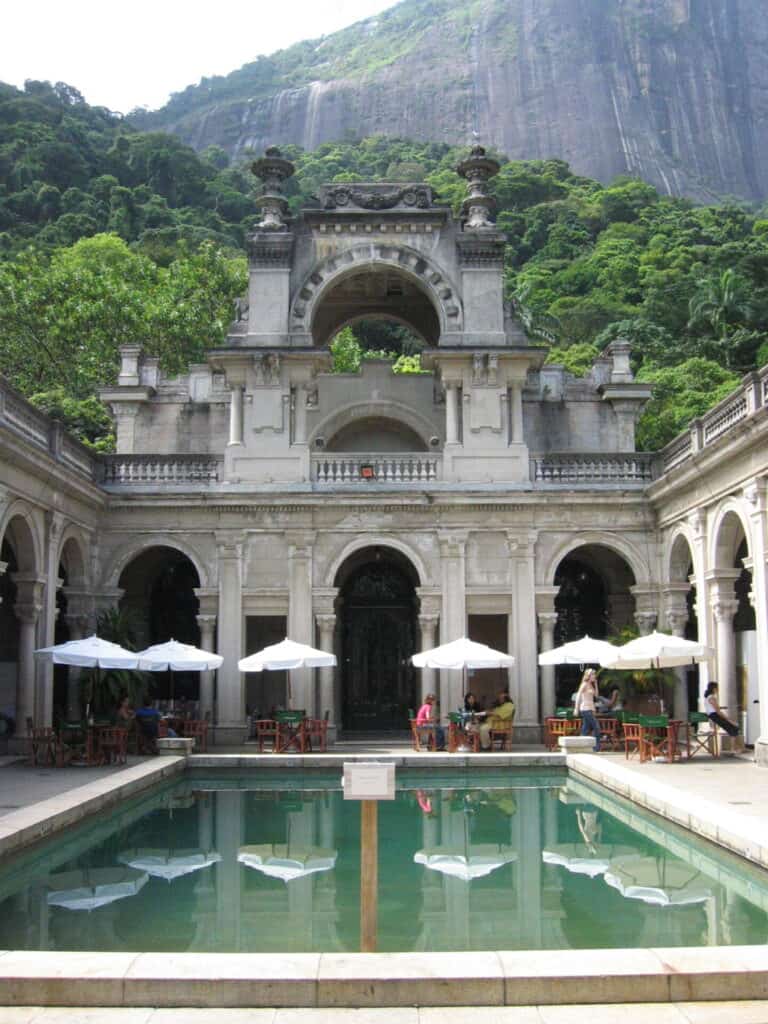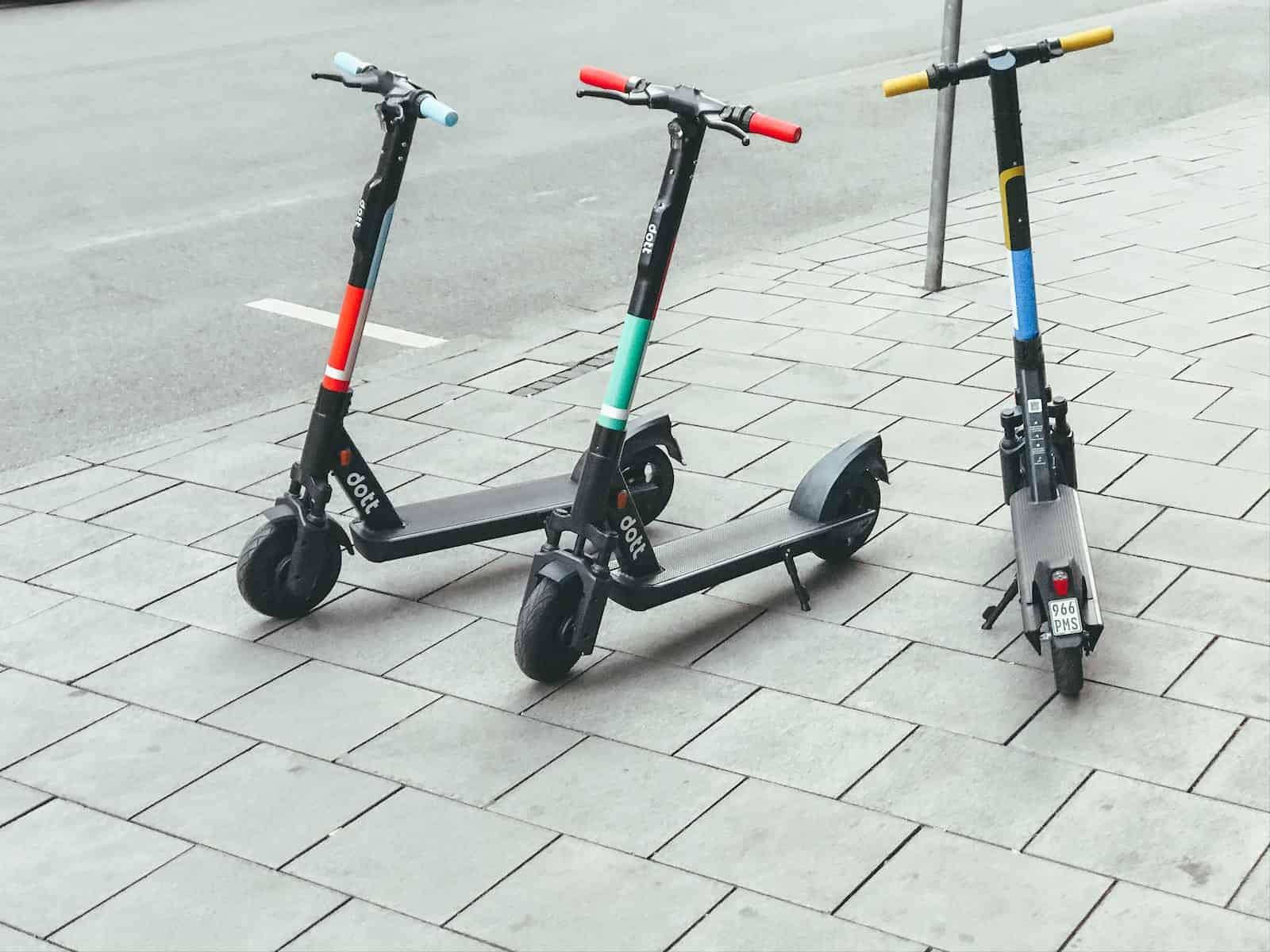
If you like nature, art, beaches, parties, dancing, or food, Rio de Janeiro will not disappoint. Somehow, this city manages to earn an A+ in my book in all of these categories. I typically try to keep my expectations low for cities that become so popular with tourists, as the authenticity tends to fade.
With Rio, that is not the case. Rio de Janeiro still has all of its charm and beauty, and the striking dynamics of nature weaved into the city’s layout are incredible.
In this guide, I’ll outline all of the best things to do in Rio de Janeiro, how to get to Rio de Janeiro, how to get around Rio de Janeiro, and more.
Watch all that we cover in this guide on our YouTube channel!
Best Things to Do in Rio de Janeiro
As one of the biggest cities in South America, Rio de Janeiro has a little bit for everyone. Whether you like nature, beaches, parties, or food, Rio has something for you. With its prime location on Guanabara Bay, Rio de Janeiro is filled with stunning beaches, natural parks, and a lively population. Here are our top recommendations for the best things to do in Rio de Janeiro.
1. Take the Train to Christ the Redeemer
Christ the Redeemer, known in Portuguese as Cristo Redentor, is easily the most iconic spot in Rio de Janeiro and one of the most famous landmarks in the entire world. The iconic Christ the Redeemer statue is a Wonder of the World sitting at the top of Corcovado Mountain, and it has been the postcard image of Rio de Janeiro since it was built about a hundred years ago.
While there are several great ways to make it to the statue, we highly recommend taking the cog train. This train leaves from the foot of the mountain and winds upward through the jungle until you’re at the base of the statue. The train ride costs either 71 or 88 reais (~$14-17.50) depending on the season and takes about 30 minutes each way. We recommend buying your tickets in advance to avoid lines and guarantee your spot in whichever time slot you prefer. On the way up we recommend sitting on the right side and on the way down sitting on the left.
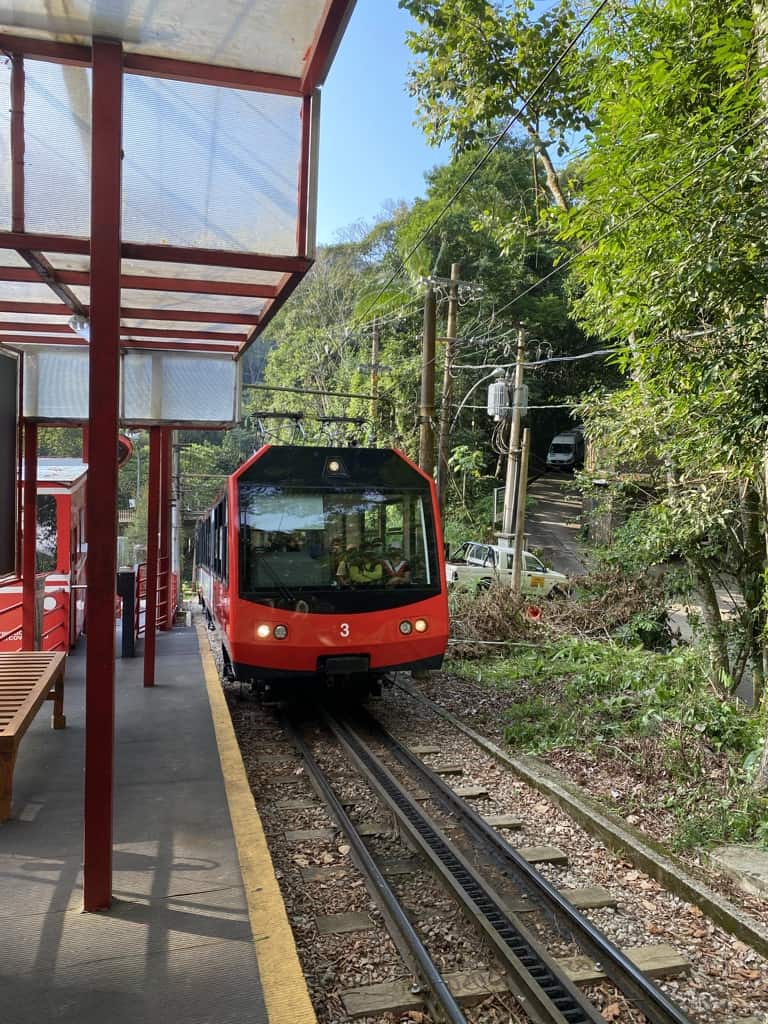
The statue is absolutely massive and is a must-visit site in Rio de Janeiro. We have a few tips to optimize your experience.
The biggest challenge when visiting Christ the Redeemer is the mountain weather.
Tips for Visiting Christ the Redeemer
Firstly, look at the statue from your accommodation before going to visit it. If it’s a cloudy day and you can’t see it from your hotel, you probably won’t be able to see it from 5 feet away, either. It is so high up that you might literally be in a cloud when you go to visit it, and you might not be able to see it very well when you arrive.
Secondly, if you’re religious, check out the little chapel that is carved into the base of the statue. It is very small and not elaborate at all, but for us, praying a rosary in a chapel right below the statue was a very cool experience.
Finally, bring a sweatshirt. We visited in autumn, and it was very brisk all the way up the mountain.
There are hiking trails that lead all the way up to the top of Corcovado Mountain from the public park at the bottom of the mountain, but these are sometimes dangerous and should only be hiked during the daytime, if at all.
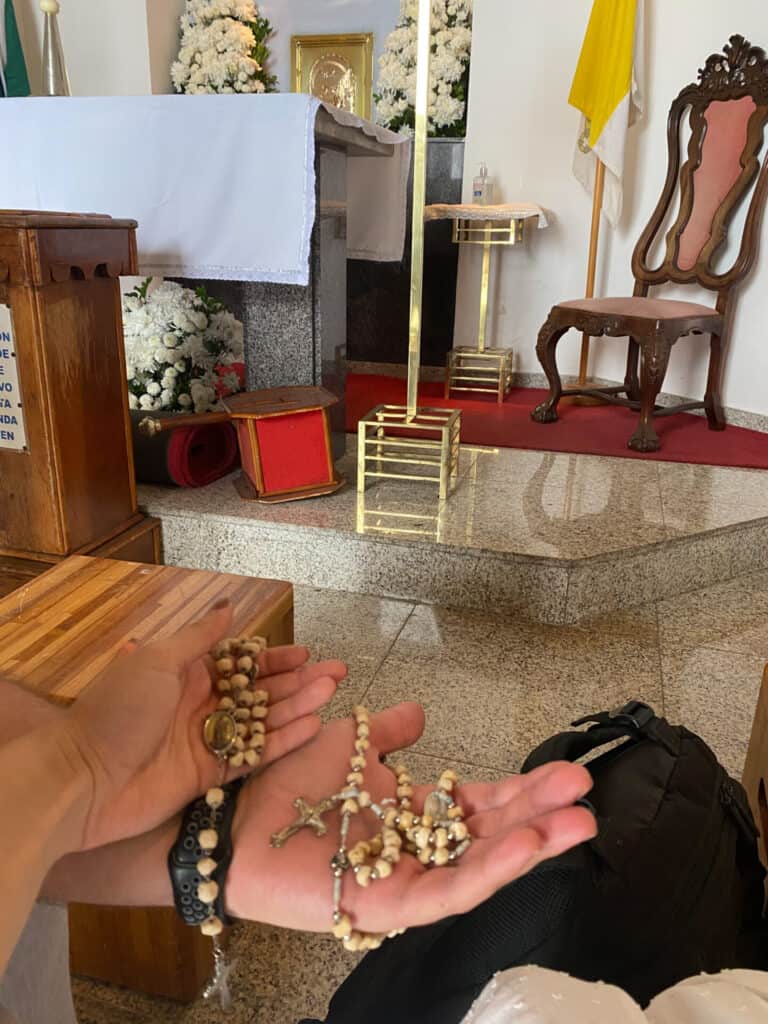

2. Drink a Caipirinha on Top of Sugarloaf Mountain
Speaking of postcard picture destinations, Sugarloaf Mountain needs to be on your list of must-see destinations in Rio de Janeiro. This gigantic, round mountain is another iconic staple of the city that you can’t miss while you’re in town.
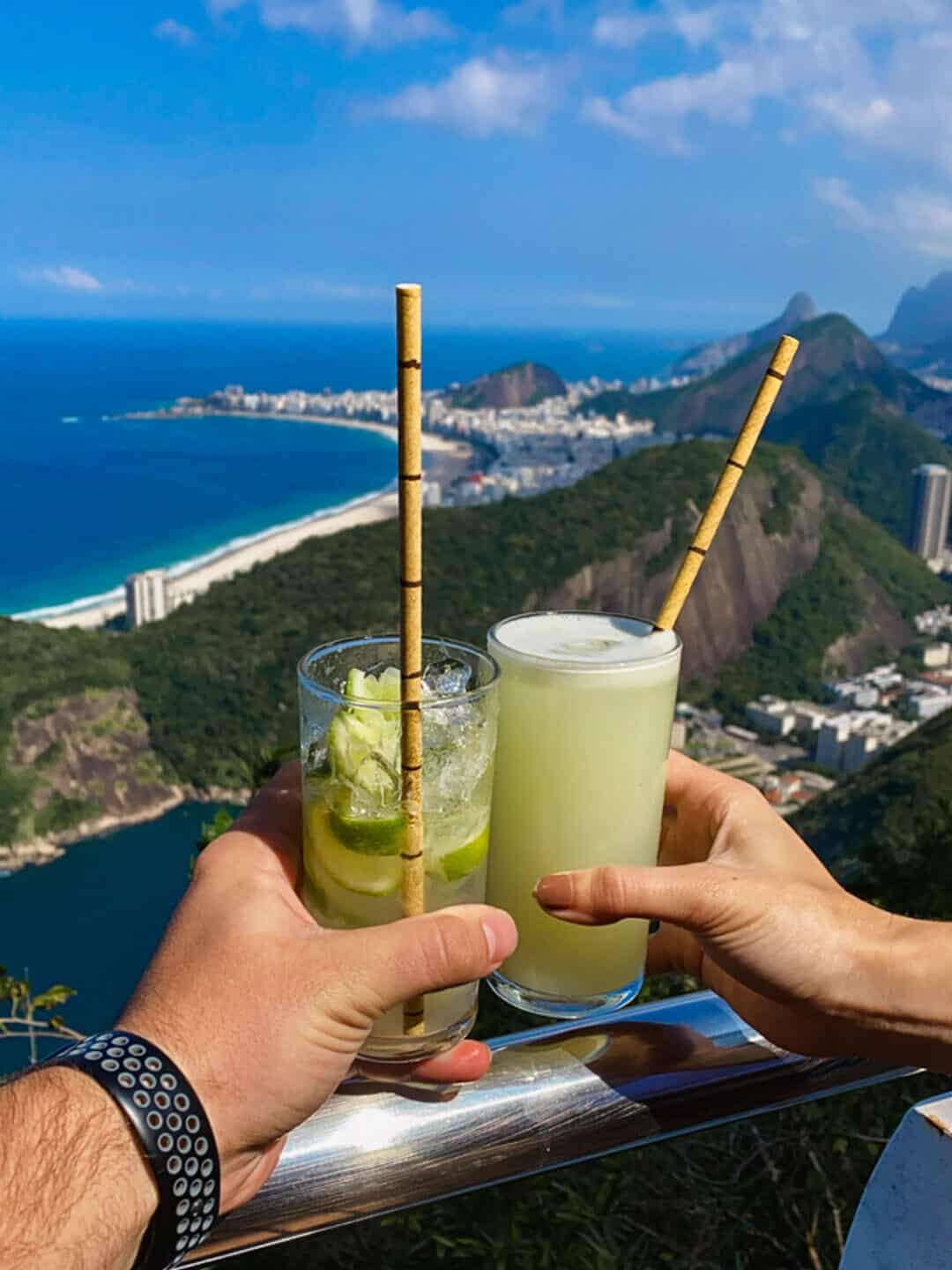
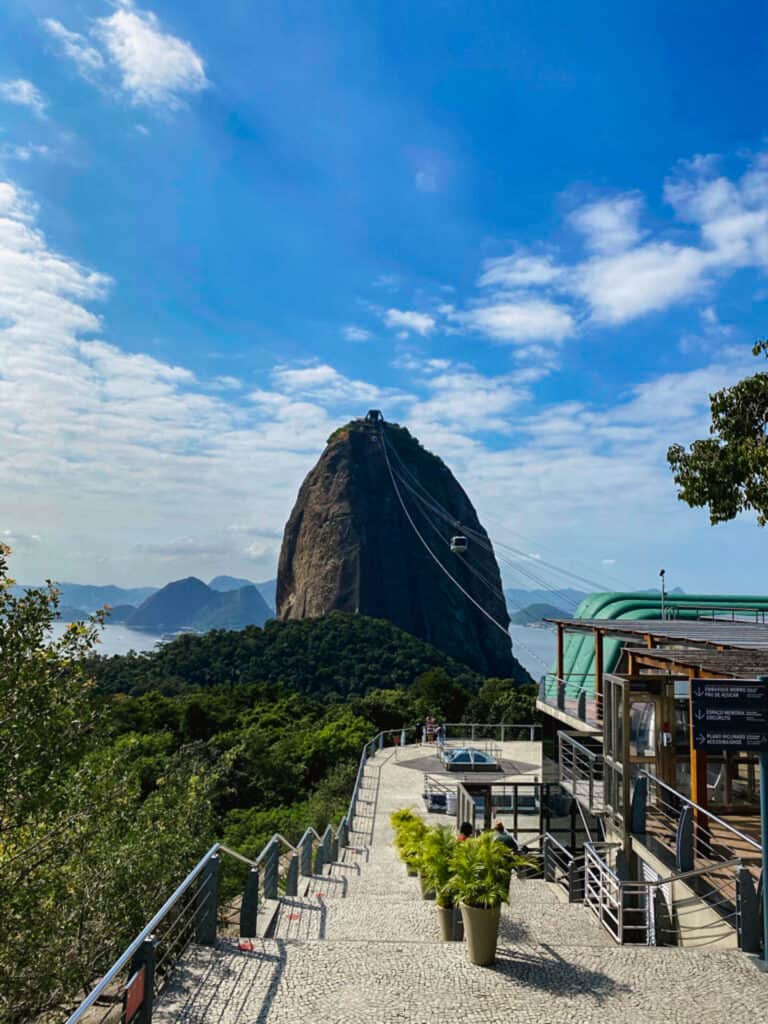
To get to the top of Sugarloaf Mountain you’ll need to take a cable car ride from the base of the mountain to the short Urca Mountain (Morro da Urca) and then another cable car up to the peak of Sugarloaf Mountain. The round-trip ticket costs 120 reais ($24) and is worth every penny. If you buy your tickets in advance here, you can save a couple of bucks.
At both levels, there are several shops and restaurants, and we definitely recommend waiting until you’re at the top level to grab a bite to eat. There is a great restaurant that overlooks the entire city and offers some incredible panoramic views. We sat down for Caipirinhas here while we absorbed the beautiful views and scenery, and the drinks were pretty solid. The food also looked great but we had already eaten on the first level of the journey.
While you’re on the top there are several great places to take pictures as well as a few easy hiking trails. If you’re lucky, like we were, you’ll run into a monkey or two!


3. Work Out on Copacabana Beach
Copacabana Beach is one of the most famous beaches in the world, due largely to its unique culture and vibe. One of the best things to do in Rio de Janeiro is to work out on Copacabana Beach in the morning. Our Airbnb was in Copacabana, so getting to the beach was only a 5-minute walk. We tried to get there for the sunrise every morning so that we could get our work out in with a gorgeous sky view each day.
Something very cool about Copacabana Beach is that you’ll never be alone, and you’ll never be the only one working out! Even at 5am there are people running, doing yoga, or doing their own personalized workouts on mats in the sand.
Even at 5 am there are people working out on the beach!

4. Eat Endless Cuts of Meat at a Churrascaria
Brazilian steakhouses are my happy place. The rehearsal dinner before our wedding was at Fogo de Chao, and at the time we didn’t realize that this chain is authentically Brazilian! If you’ve ever been to Fogo de Chao or any other Brazilian steakhouse in the United States, you probably know what I mean when I say that you should skip breakfast the day that you go.
These restaurants have waiters that walk around with skewers of fresh, fine cuts of meat and they cut it right off of the skewer onto your plate. If all-you-can-eat filet mignon sounds too good to be true…well, it isn’t. That’s literally what you can expect at a churrascaria, plus so much more!


We went to two different churrascarias while we were in Rio. First, we went to Carretao in Copacabana, and we were thoroughly impressed. It was better than Fogo de Chao in the United States and for half the price. A few days later we went to the original Fogo de Chao in Botafogo, and we were actually underwhelmed.
The food was great, but Fogo de Chao in the United States is significantly better. The meats were equally great, but the table of sides and complimentary dishes was very subpar. Not to mention it was almost twice the price of Carretao! On our next trip to Rio, we’ll absolutely be choosing Carretao over Fogo de Chao.
5. Grab a Deluxe Breakfast at Confeitaria Colombo
Confeitaria Colombo is a Deluxe tea house with a few locations without the city. We heard that the one in the Copacabana Fort is lovely, but we opted for the one that is a stone’s throw away from the Royal Portuguese Reading Room. This tea house has great tea and serves it alongside fresh-baked pastries.
For a very reasonable price, you can opt for a full breakfast service including many pastries, salty snacks, breads, tea, and juice. This is what we went with, and it was worth every penny. If you’re looking for a nice breakfast and enjoy tea and carbs, you can’t do much better than Confeitaria Colombo. There isn’t a dress code, but dressing nice here definitely enhances your experience and makes for an elegant morning.
6. Take Some Instagram Pictures at the Royal Portuguese Reading Room
The Royal Portuguese Reading Room is an old library located in the heart of the city. Filled with books that are hundreds of years old, walking into this room is a really unique experience, much like visiting the library at JP Morgan’s house in New York City.
While the Reading Room is a beautiful sight to take in, one of the most common things to do here is to capture its essence with a very Instagram-worthy picture, like the one in this post. Entering the room is free and you really don’t need more than 10 minutes here, but it’s definitely worth the stop.

7. Visit the Rio de Janeiro Botanical Garden
The Rio de Janeiro Botanical Garden, or Jardim Botânico as it is called in Portuguese, is one of the most popular attractions in the entire city. Rio is a very unique city, in that it is built so intertwined with the nature surrounding it. The Botanical Garden offers a look at many of the plant species that are found in the area, plus species from other parts of the world. Notably, there are many species of orchids that I highly recommend checking out.
One of the places you don’t want to miss while visiting is the Japanese Garden, which is an area of the Botanical Garden filled with Bonsai trees and other plants indigenous to Japan. After all, Brazil has one of the largest Japanese populations in the world!

8. Go for a Free Walking Tour of Downtown Rio
I like to go on a free walking tour whenever I can, as I think that walking tours are the best way to see almost any city. In Rio, this is absolutely the case. Many of the top things to do in Rio, like the Imperial Palace, cathedral, and Municipal Theater, can be seen while on a guided tour.
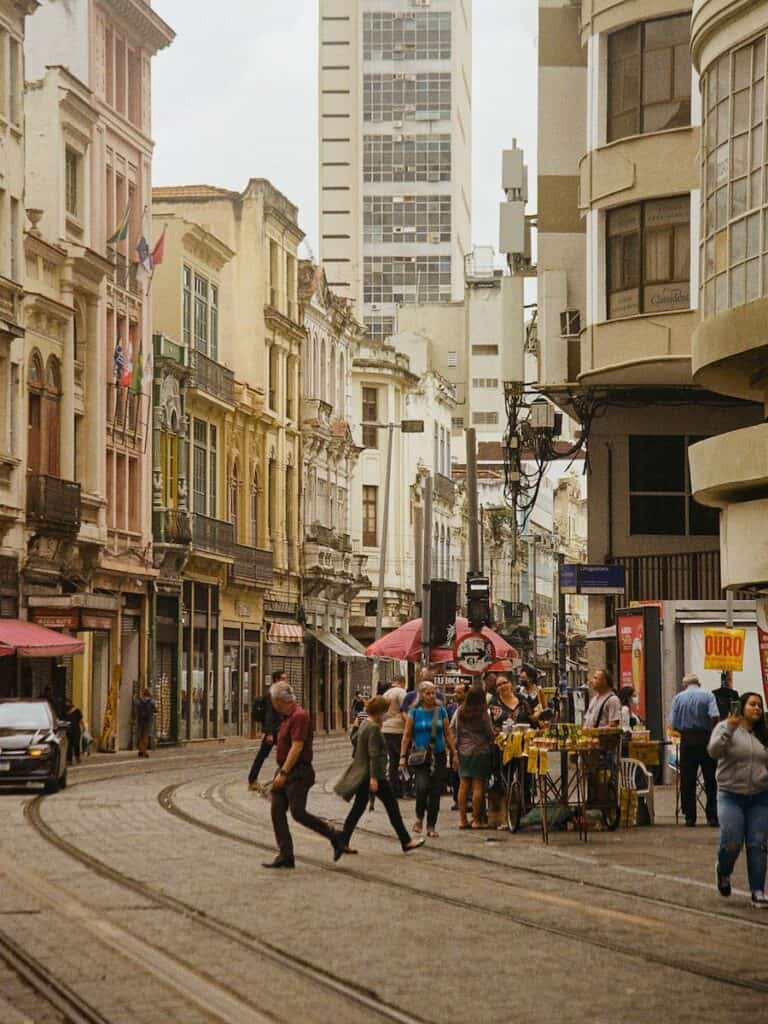
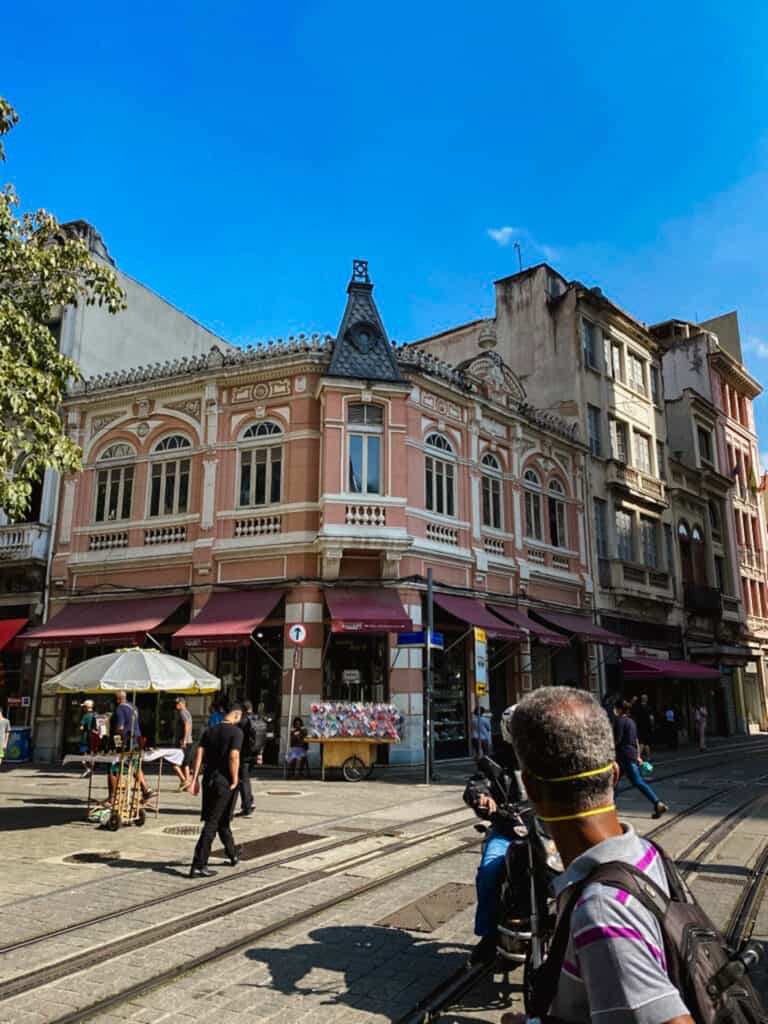
Having the knowledge of a local guide while you explore Rio for the first time is a huge advantage. While some of the city’s most iconic destinations are not located right in the heart of Rio, the guide is likely to provide information that is useful when you visit them on your own.
9. Go for a Day Trip to Ilha Grande
Ilha Grande is one of Brazil’s biggest islands, and it sits just off of the Atlantic Coast just a couple of hours south of Rio de Janeiro, near the town of Angra Dos Reis. This little island is incredibly unique, as I wrote about in my Ilha Grande travel guide, as it is very raw and does not have any cars.
If you are looking for a place outside of Rio where you can have a relaxing, good time, Ilha Grande is the top place to go. The island is filled with hiking trails of all difficulty levels, some stunning beaches, and a couple of gorgeously colored lagoons.
We opted to use luggage storage in Rio and only take the things we needed along to Ilha Grande. The ferries are pretty small, and the fewer thing you take, the better.

10. Relax on Ipanema Beach
Ipanema Beach is much more relaxed than Copacabana Beach. While it is still one of the most popular beaches in all of Rio, the vibe is a bit more relaxed the Copacabana. Ipanema is one of the most important neighborhoods in Rio, and its beach is a great spot to unwind with a book. Another common relaxing beach is Praia Vermelha, which is even less popular but is significantly smaller.

11. Climb the Selaron Steps
The famous Selaron Steps, or Escadaria Selarón in Portuguese, are a set of outdoor steps covered in mosaic tiles. The Escadaria Selaron is easily one of the most recognizable attractions in the city, and its location between Lapa RJ and Santa Teresa Neighborhoods makes them an extremely popular place to hang out on a Friday night. While it is a major tourist attraction, you will likely find both tourists and Rio residents here at any given time.
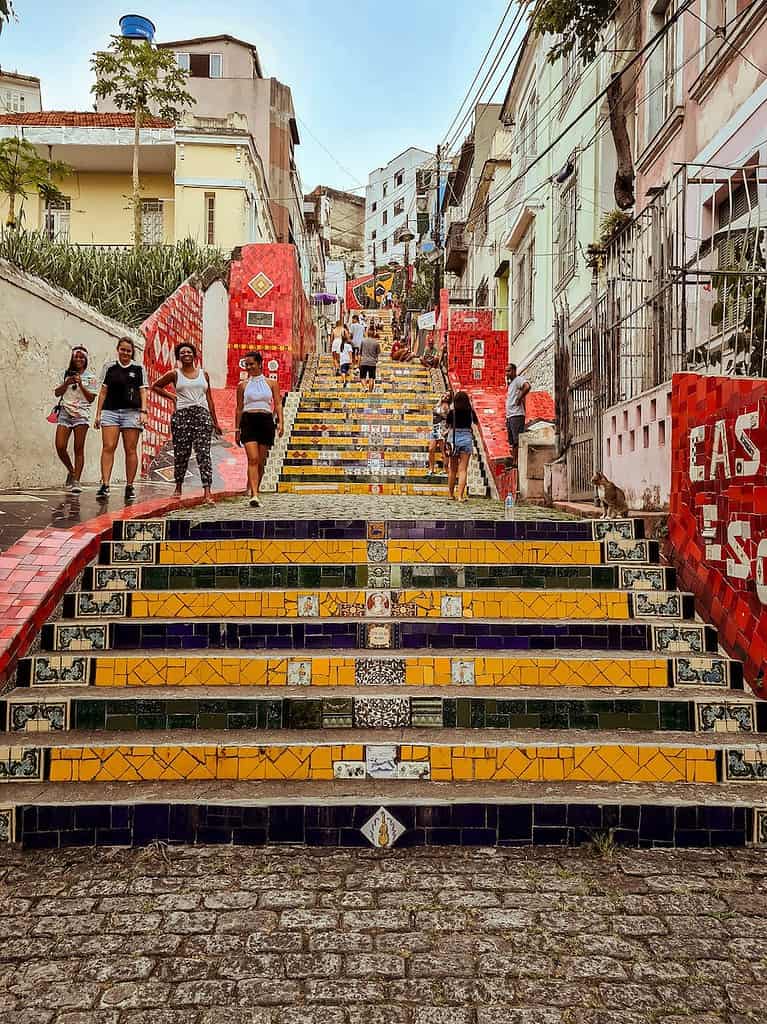

12. Go Hiking in Tijuca National Park
Tijuca National Park, or Parque Nacional da Tijuca in Portuguese, is a massive public park in Rio. The Botanical Garden, Pedra da Gávea, Corcovado Mountain, and Parque Lage are all located within the park, and they all made this list by their own merits. However, one of the best things to do in Rio de Janeiro is simply to go hiking in this massive, beautiful park. It is certainly a natural park and not a manmade urban park like Central Park in New York City, and the bird’s eye view of the city from some of the park’s peaks is simply stunning.
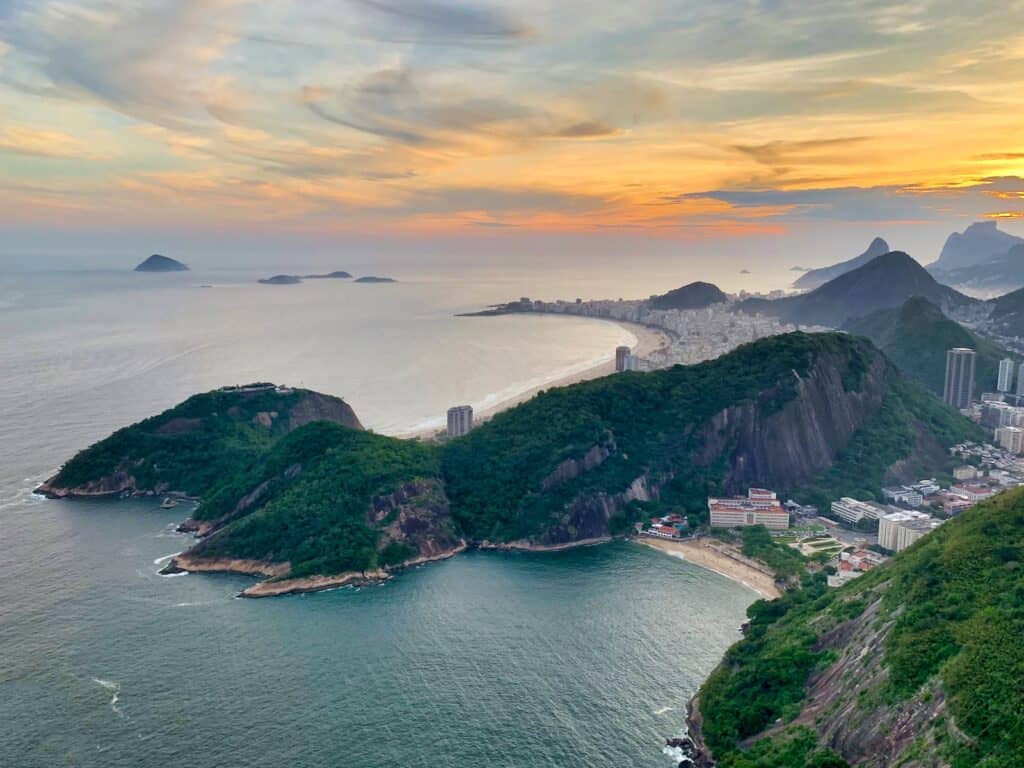
13. Attend a Soccer Match at Maracanã Stadium
Rio de Janeiro is the only city in Brazil that has hosted the Olympic games, but it also helped to host the FIFA World Cup in 2014! This World Cup was played in stadiums all over the country, including the now-iconic Maracanã Stadium in Rio de Janeiro. This stadium is one of the most famous stadiums in all of Brazil, and it is currently the home of two Brazilian soccer teams. Many consider this stadium to be a soccer Mecca, and attending a match here is often seen as a Rite of Passage for Brazilian soccer fans.
14. Attend Dance Lessons at one of Rio’s Famous Samba Schools
Samba is a style of dance that comes from Brazil, and it is especially popular in Rio. Born in Rio’s favelas, samba has developed into one of the most important cultural traditions that Brazil has to this day. From street parties to Carnival to the occasional samba parade, this style of dance works its way into musical performances all throughout the city. If there is live music being played, it will very often be accompanied by samba dancing!
As the dance style was born in Rio itself, the city is filled with the country’s best samba schools. One of the best Samba schools in Rio is in the neighborhood of Rocinha, which is the largest favela in Rio de Janeiro.
15. Explore the Grounds of Parque Lage
Parque Lage is a very Instagrammable complex within Tijuca National Park that gets much fewer visitors than the nearby Botanical Garden. The park used to be owned by a rich industrialist, and the park has since become one of the most under-the-radar attractions in Rio. While the Botanical Garden is bigger, Parque Lage receives significantly fewer tourists and is almost as beautiful.
16. Visit the Museum of Tomorrow
The Museum of Tomorrow, or the Museu do Amanhã in Portuguese, is a famous science museum in Rio dedicated to the future of Earth. This museum is huge, and it is filled with very inspiring and thought-provoking exhibits. It is built right on the water in downtown Rio de Janeiro, and I highly recommend checking it out while you have the time. Be sure to check the museum’s hours in advance to guarantee that it is open while you plan to visit.

17. Take a Picture at Pedra Bonita
The Pedra Bonita is a famous rock formation a short distance outside of the city. This rock formation became popular on Instagram, as certain photo angles make it look like people are dangling from the stone with nothing below them. In reality, taking this picture isn’t actually dangerous at all, and it is just an illusion. Still, the pictures are iconic and taking them is a very popular thing to do in Rio.
The Pedra Bonita is a bit of a trip away from the most popular areas of Rio, and I advise coordinating transportation in both directions before you head there. The rock formation is not entirely unserviced by Ubers, but you always want to make sure that you don’t get stranded there.

How to Get to Rio de Janeiro
If you’re flying to Rio de Janeiro, there are two potential airports that you can fly into. Galeao International Airport (GIG) is the main international airport of Rio de Janeiro. Galeao Airport is about 25 to 30 minutes north of the most popular Rio de Janeiro neighborhoods, like Copacabana and Ipanema.
This airport services just about every international flight into Rio, and if you have a direct flight to Rio de Janeiro, you’ll be landing here 99 times out of 100. To get from the airport to your accommodation, you can use the airport’s free wifi to call an Uber, which is definitely your best option.
The other airport in Rio de Janeiro is Santos Dumont Airport (SDU) which is the domestically focused airport of the city. If you’re flying from anywhere else in Brazil, you might fly into this airport. Additionally, if you’re flying from another country but connecting in a hub city like São Paulo it’s possible that you’ll land here, too.
Santos Dumont Airport is located right in the city center, which makes it an extremely convenient airport to use. From Copacabana and Ipanema, Santos Dumont Airport is only a 10-to-15-minute drive. If you’re able to find a decent flight price, I absolutely recommend flying into this airport.
From either of these airports, I recommend taking an Uber to get to your accommodation. While there are great public transportation options, Ubers are very affordable in Brazil, and the drive from Galeao Airport passes by Corcovado Mountain and the Christ the Redeemer statue. This is a magical thing to see while driving into the city, and the travel time in an Uber is actually much faster than the time on the train and metro.
How to Get Around Rio de Janeiro
UBER | TAXI | BUS | METRO | ELECTRIC SCOOTER
Getting around Rio de Janeiro is very easy. Firstly, as I mentioned in my Sao Paulo travel guide, Uber is incredibly cheap and perfectly safe in Brazil. You can take an Uber the length of the city for less than 25 reais, or about $5, and Uber is always a safer bet than taxis while traveling.
Unless you happen to be staying right next to a metro or bus station, Uber is absolutely the best way to get around Rio. The app works the same as it does in any other place, as long as you have an internet connection. If you aren’t comfortable or familiar with Uber, you can also opt for taxis.
Uber is always safer than taxis.
We tend to think that taxis are a bit less safe than Uber, but the taxi that we took in Rio was perfectly safe and used the meter to fairly determine the price.
Rio’s Metro and Bus Network Are Broad and Safe
If you are staying near a bus or metro station, you can also opt to use either of those systems. While we didn’t have a need or opportunity to use the buses, they seemed clean and very well-connected to parts of the city.
We used the metro system, though, and it was clean, air-conditioned, and efficient. You can buy single-use tickets in any metro station for a bit under 5 reais, or $1 per trip. The metro takes you up and down the city’s spine and can wind up being a cheap and convenient option depending on where in the city you’re going.
In addition to Uber and public transportation, a few neighborhoods are stocked with shareable electronic scooters operated by Lime. If you’re not sure how these work, check out my guide on using shareable electronic scooters.
The Best Time to Visit Rio de Janeiro
Rio’s location on Brazil’s east coast makes it a great place to visit for the majority of the year. The best times to visit Rio certainly revolve around the city’s summer months and its shoulder seasons, which generally run from October through March, which also coincides with Carnival.
We recommend visiting during Rio’s summer months which also happen to coincide with Carnival.
As Brazil is located in the Southern Hemisphere, its winter runs from June to August and its summer runs from December to February. These seasons are the opposite of what most travelers expect, as 90% of the world’s population lives in the Northern Hemisphere.
While the winter weather is usually too cold for a beach day, it is still very pleasant. We were in Rio in May, which is late autumn, and we had a great time on the beach soaking up some sun.

Is Rio de Janeiro Safe to Visit?
Before we visited Brazil, we heard a lot of negative things about safety. The U.S. State Department had a lot of negative things to say about crime in Brazil, and while I am normally very skeptical of these travel warnings, I was concerned about visiting Brazil.
I had always heard about crime in Brazil. From violence to kidnapping and drug-related crimes, I had heard that Brazil has some real safety concerns and that it really is a place you want to avoid. On the other hand, I had heard from people who visited that Brazil is not really all that dangerous and that things tend to be overblown.
Is Rio de Janeiro Really Dangerous?
There is no straightforward answer to this question, and making generalizations about safety is always dangerous. However, I can offer some light on the situation based on my own experience.
I asked locals and expats that I knew in the city before I visited, and they offered up a wide array of answers. Their opinions formed my opinion before I visited, and hopefully my advice is useful for you before you travel.
I lived in Mexico for two years, and during that time I traveled all around the country. Mexico, like Brazil, is a place that has a nasty reputation for crime and violence. What I found is that if you keep yourself out of trouble, the odds of things happening to you are very low. In Brazil, I believe a similar approach applies.
Just like we learned through living in Mexico, if you’re smart and safe, trouble most likely is not going to find you.
Rio Has Several Dangerous Neighborhoods
Rio de Janeiro has several dangerous neighborhoods, some of which are extremely dangerous. You should avoid these types of places at all times. However, when you are in the right parts of the city, there is very little threat to you at all – similar to any major city in the United States.
We walked around popular parts of Rio at all times of day and night and never once had even a feeling of imminent danger. For a normal person doing normal things, Rio is a perfectly safe place to visit. After all, it is one of the most famous cities in the world, and millions of people live there.
Like anywhere, it is important that you practice common sense and keep yourself out of compromising or threatening situations. For example, I would not recommend going into any favelas without a local guide, and even then I would make sure that all tours take place during the daytime and with a reputable organization. I would not recommend flashing any valuables, especially at night, and I would only carry the cash and credit cards that I need each time I step out into the streets.
We do not recommend traveling to favelas alone.
Rio Is Safe if You Take Precautions
All in all, Rio is a beautiful city filled with beautiful people. If you take general safety precautions and operate on medium alert at all times, you will probably be just fine. If you go to the beach, only take the things you need.
Anything you leave on the beach might not still be there when you get out of the water. Use Uber instead of taxis. Carry minimal amounts of money. Stay out of favelas, and avoid the downtown area late at night. If you do these things, you probably will have nothing to worry about.
Is Rio de Janeiro Worth Visiting?
Rio de Janeiro is one of the most iconic cities in all of Latin America, and many people argue that it is the best place to visit in all of Brazil. While I am very fond of Sao Paulo, there is no denying that Rio de Janeiro deserves its reputation as an amazing place to visit. It is the only Brazilian city to ever host the summer Olympics, and there are countless places within the city that are worth seeing.
This city is a major cultural center in Brazil, and it is the perfect place to meet Brazilian people and experience their culture. Its location right on the Atlantic Ocean provides access to some beautiful beaches with golden sands and lively crowds, while the natural beauty of places like the Tijuca Forest and Sugar Loaf Mountain offers up some spectacular views of the city and its nature. If all of that weren’t enough, Rio’s generally low cost of living makes it a very affordable destination.
All in all, Rio de Janeiro is a beautiful place in South America’s biggest country that is absolutely worth visiting.
Rio is filled with delicious food, wonderful cultural institutions and attractions, beautiful natural parks, and some of the liveliest people in all of Brazil. If you are looking for a place to visit in Brazil, there is no doubt that Rio is worth visiting.

When Is Rio Carnival?
Carnival in Rio takes place between the Friday before Ash Wednesday and Ash Wednesday itself every year, totaling five days. These dates change each year as they are dependent on the Catholic Liturgical calendar, but they are normally in either February or March.
In 2023, Carnival will take place from February 17 to 22.
That’s all we have for you about Rio de Janeiro! Hopefully, this guide helps you with planning the ultimate Rio de Janeiro trip. If you’re heading to Rio de Janeiro, you should consider going to Ilha Grande, too! If you have any questions be sure to drop us a comment!



